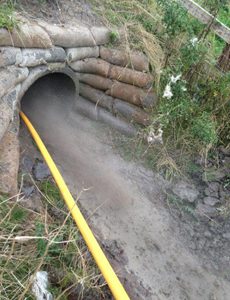
Lanes Group drainage engineers have carried out a pipe cleaning project with the longest jetting hose they have ever deployed – and all to help badgers cross the road.
The Lanes team based in Derby was handed the challenge of cleaning a badger tunnel under the A46 in Nottinghamshire after it became completed blocked by silt and stones.
Without the tunnel, badgers whose territories are intersected by the road, near Bingham, would have to cross the dual carriageway, endangering their lives, and those of road users.
An estimated 45,000 badgers are killed on Britain’s roads each year, and badger regularly cause road accidents across the county, some of them resulting in fatalities and serious injuries.
To clear the badger tunnel safely and cost-effectively, the only practical method was to deploy Lanes Group’s powerful jetting technology. This uses a jet of water at up to 2,000 pounds per square inch to force debris from the pipe.

The problem was that the badger tunnel, which is just under one metre in diameter and more than 100 metres long, was on a remote stretch of the main road – with no safe hard standing area for drainage vehicles nearby.
Chris Norbury, Area Development Manager for Lanes Derby, said: “The easiest option would have been to place our jet vac tanker on the A46 and run a jetting hose to the badger tunnel directly below.
“However, due to traffic management issues, this was not an option, so the answer was to create a jetting hose that was half a mile long, the longest run we’ve ever created in the East Midlands.”
This was achieved by placing a jet vac tanker next to a balancing pond – used to collect water run-off from the trunk road – which was the water source closest to the badger tunnel.
The jet vac tanker’s jetting hose was then linked up in relay to the hose reels of three Terra Jets – tracked remote access jetting machines – each of which contained 200 metres of hose. This created a continuous hose more than 800 metres in length.
The hose was run to the downstream end of the badger tunnel where engineers used plough-jetting attachments to clear the pipe.
The final piece of the jetting jigsaw was to use pumps to continuously feed the jet vac tanker with water from the lake.
Before work could begin, an excavator was used to lower the badger run ‘outfall’ area to receive the washings from the jetting process.
To prevent a cropped field next to the worksite becoming contaminated with the washings, the debris was pumped through a series of filter bails so it would dissipate naturally.
Chris Norbury said: “The plan worked, and despite some difficult conditions, including freezing temperatures, we cleared the badger tunnel in four days. In all, three tonnes of debris was removed.”
Chris Norbury added: “Technically, this was a big challenge. We were, quite literally, close to the extremity of what’s possible. It was especially gratifying that we were able to use this innovative approach to support wildlife protection.
“Many people will still remember the Tufty Club road safety campaign with Policeman Badger helping young animals across the road. So it seems absolutely right that we should help badgers cross roads safely themselves, where we can.”
Despite the Highway Agency’s creation of badger tunnels on large road schemes, road strikes are the main cause of badger deaths, with an estimated 15 per cent of the UK’s badger population killed on roads every year.
Badger conservationists say summer is one of the most high risk periods for badgers, as they roam further afield for food needed to feed cubs born in spring. More information about Lanes’ de-silting work is available here.







